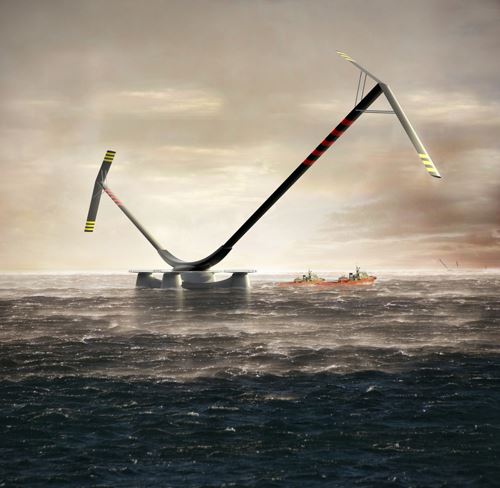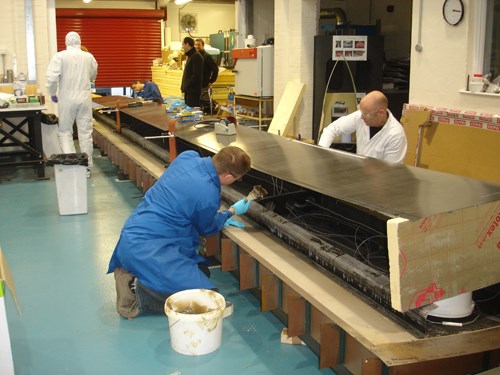Novel offshore wind energy system relies on carbon fiber sails
The 50-kW Nova project features a composites-intensive offshore, double-arm, vertical axes wind turbine system (VAWTS) that will investigate the affordability and feasibility of manufacturing this innovative energy system.
A key milestone has been achieved for the U.K. Nova project team with the successful construction of the sails for a fully working 50-kW prototype demonstrator of its new concept 10-MW offshore, double-arm, vertical axis wind turbine system (VAWTS). Nova is a two-year renewable energy feasibility project, supported by the UK Energy Technologies Institute (ETI) and the Engineering & Science Research Council (EPSRC), with financial support from the European Regional Development Fund (ERDF). The project aims to investigate the affordability and feasibility of manufacturing a VAWTS of this design and scale. The NOVA project 50-kW VAWTS demonstrator will be located on the Cranfield campus and be operational starting in October 2012.
The 50-kW prototype was manufactured at Cranfield University’s Composites Centre, with extensive advice and support in the design and manufacturing provided by key material suppliers. This included Scott Bader Company Ltd. (Wellingborough, U.K.), whose Crystic Crestomer 1152PA urethane acrylate structural adhesive has been specified for the light-weight structural bonding of the various carbon fiber and glass fiber epoxy composite parts that comprise the two 10 by 1.9 mrotor sails. To be viable, the planned massive scale-up in offshore wind turbine manufacture will require the rotor blades to sustain at least 20 years’ service without maintenance. As such, the structural design and selection of suitable high quality materials with these long term performance capabilities is a critical success factor for this project.
By first developing a 50-kW prototype scaled down demonstrator with embedded structural strain and air pressure monitoring, the Nova Project team will be able to gain an understanding of the engineering performance and aerodynamic behaviour of the design in use and extensively test in offshore operational conditions the composite materials selected.
The fabrication stage has already helped the company address on a smaller scale any processing challenges to cost-effectively manufacture and assemble the composite components; these can then be applied to the full-sized version to help ensure its affordability and commercial viability. This novel vertical axis turbine design aims to become a fully commercialized 10-MW offshore wind turbine, which will have two 160m arms supporting two 80m-long V-shaped sails; when built, it would be the heaviest composite construction in the world, weighing about 160 metric tons.
The overall wind turbine assembly has been designed and constructed to have the best structural reliability long term in order to meet the key criteria of being maintenance free during its expected 20-year service period. The two prototype rotor sails each have dimensions of 10m long by 1.9m wide, with a maximum depth of 180 mm at the mid section. The structural approach used for the rotor sails is similar to a large commercial aircraft wing. The sail has a central box section, designed with tapering thickness skins, two C spars with ribs and omega-shaped hat stringers to provide resistance to buckling. The sail central box components were manufactured from multi-directional carbon fiber fabrics and epoxy resin using a vacuum infusion molding process. To the central box is added glass fiber-reinforced leading and trailing edge components.
Bearing in mind that the scaled up 10 MW wind turbine sails would be 80m long, finding ways to reduce weight in the overall sail design was critical. For the prototype, the rotor sail weight was significantly reduced by using a structural adhesive, which had the added benefit of also providing lower overall manufacturing costs compared to a jointed sectional and mechanical assembly design. The carbon fiber epoxy ribs, spars and skins of the box design were bonded together with Crystic Crestomer 1152PA structural adhesive. The leading and trailing edge components, separately fabricated from glass fiber epoxy resin, were then bonded onto the central box of the sail using Crystic Crestomer 1152PA. All the bond joints used a simple joggle design and shim plates to allow for rapid assembly with minimum fixtures and aerodynamically smooth joints.
As the adhesive was such a critical factor in both the manufacturing and long-term offshore performance of the two lightweight rotor sails, Cranfield University Composites Centre carried out its own detailed study to evaluate a range of possible adhesives for this demanding application. Andrew Mills, Nova project leader at Cranfield University Composites Centre, says: “The design and scale of the sail rotor structure means that there are large bond surface areas and wide bond lines. The fully cured structural adhesive must, therefore, have long term performance properties which meet a number of key requirements. These include gap filling and providing outstanding peel resistance, while at the same time being strong and very tough, with exceptional flexural strength properties.”
The adhesive performance comparative testing carried out by the Cranfield project team was done out on a range of bond-line thicknesses from 30 mm down to 2 mm. The test results obtained showed that the best performing adhesive for bonding both carbon fibre and glass fibre epoxy laminate substrates was Scott Bader’s Crystic Crestomer 1152PA structural adhesive. For the 10m sail prototype, each component and mold tool was designed with joggled ggled part fit, scored fitting positions and 1-mm adhesive shims; this provided accurate final sail dimensions without the use of complex assembly jigs. As part of the assembly process to ensure joint accuracy, after positioning without adhesive, each part was drilled and the holes used to either pin or rivet each part together after adhesive application. All of the adhesive joints were post-cured in a portable, taped foam board oven for 24 hours at 50°C and joint gaps were subsequently filled with a body filler and abraded smooth using a circular sander to eliminate evidence of the component joints.
Related Content
Materials & Processes: Composites fibers and resins
Compared to legacy materials like steel, aluminum, iron and titanium, composites are still coming of age, and only just now are being better understood by design and manufacturing engineers. However, composites’ physical properties — combined with unbeatable light weight — make them undeniably attractive.
Read MoreMaterials & Processes: Resin matrices for composites
The matrix binds the fiber reinforcement, gives the composite component its shape and determines its surface quality. A composite matrix may be a polymer, ceramic, metal or carbon. Here’s a guide to selection.
Read MoreMoving toward next-generation wind blade recycling
Suppliers, fabricators and OEMs across the composite wind blade supply chain ramp up existing technologies, develop better reclamation methods and design more recyclable wind blades.
Read MoreDrag-based wind turbine design for higher energy capture
Claiming significantly higher power generation capacity than traditional blades, Xenecore aims to scale up its current monocoque, fan-shaped wind blades, made via compression molded carbon fiber/epoxy with I-beam ribs and microsphere structural foam.
Read MoreRead Next
Composites end markets: Energy (2024)
Composites are used widely in oil/gas, wind and other renewable energy applications. Despite market challenges, growth potential and innovation for composites continue.
Read MoreFrom the CW Archives: The tale of the thermoplastic cryotank
In 2006, guest columnist Bob Hartunian related the story of his efforts two decades prior, while at McDonnell Douglas, to develop a thermoplastic composite crytank for hydrogen storage. He learned a lot of lessons.
Read MoreCW’s 2024 Top Shops survey offers new approach to benchmarking
Respondents that complete the survey by April 30, 2024, have the chance to be recognized as an honoree.
Read More











.jpg;maxWidth=300;quality=90)

















